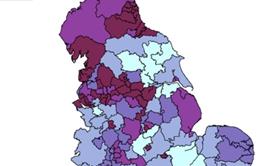How the NHS, local government and others in West Yorkshire are trying to mitigate the greater threat from covid-19 to more deprived and excluded groups.
We know that the impact of covid-19 is felt the greatest by our most deprived communities, and growing evidence supports this. In West Yorkshire we are committed to tackling the direct and indirect health implications of covid-19, and most importantly doing something about it.
Our five year plan sets out our ambitions to reduce the gap in life expectancy by 5 per cent in our most deprived communities by 2024; reducing health inequalities for children living in households with the lowest incomes, and reducing suicide by 10 per cent, whilst strengthening local economic growth and improving skills. Acknowledging these priorities has enabled us to respond to the inequalities we are facing as a result of covid-19.
Later diagnosis of health issues will need to consider the wider determinants of healthy lives and this is why the collective approach of the ICS, Local Resilience Forum, West Yorkshire Combined Authority, Leeds Economic Regional Partnership, Yorkshire and Humber Academic Health Science Network, universities, and others, remains important.
Only by bringing specialisms together with the effective use of research and intelligence can we make a difference to those hardest hit, including black, Asian and minority ethnic populations, those in poverty, people with mental health, learning disabilities and carers (or all).
The disproportionate deaths of BAME health and care staff during the covid-19 pandemic brings this into sharp focus and calls for immediate action. The WY&H BAME network has focused on leadership development; communications targeted at areas of concerns - delivered in a compassionate way. Our involvement in shaping the National Institute for Health Research work to understand the disproportional impact of covid-19 in BAME communities is welcomed.
Measures to control the spread of the virus are likely to have significant longer term implications on health inequalities, related morbidity and mortality of certain groups of people, for example those experiencing social isolation, financial insecurity and domestic abuse. Through understanding the impact on those who haven’t sought health advice or have had treatment or diagnostic tests postponed, we aim to mitigate the immediate and long term repercussions.
Our local councils are leading on the shielding programme for the extremely vulnerable through three areas: direct delivery of food, medicines and support through community pharmacy; social support, often via voluntary and community organisations who help thousands of people isolated or shielded at home.
This increased demand with limited resources has made us determined to act. The number of people shielded has almost doubled and this huge challenge has been supported by brilliant fire fighters contacting those who are at risk, and supporting our triaging of those who seek help.
We recognise the major role of our voluntary and community sector and have made available an additional £450,000 of funds to the VCS to enhance their vital work in place, tackling disadvantage and drawing on the expertise of the people who help the destitute, the disconnected, and rough sleepers.
Keeping colleagues safe and understanding the wider impact of the disease on different groups of people including care home residents, those with mental health concerns and fear from BAME communities is a priority. We are making the most of the expertise across our patch, for example the Born in Bradford research, which has recently analysed the first 1,000 responses to understand populations who are most vulnerable.
We are also looking at how we continue to turn the curve in childhood obesity among families living in the most deprived areas, where the problem is worse and hardest to tackle. Drawing on the skills of public health specialists, behavioural science and data, we are building on an existing index of older people / frailty to develop this for children.
Using all available intelligence and insight to understand the inequalities arising due to covid-19, and how we plan to mitigate against this through targeting preventative interventions, can be seen in the work taking place with the Leeds City Region Housing Association Partnership around the support and offer from Housing Associations. This coupled with our councils who have worked hard to house homeless people in a matter of weeks to keep them safe, is putting us in good stead.
Signing the healthtech industry memorandum of understanding last year with the five universities will also accelerate health technology innovation to further combat health inequalities, making it clear that an effective response to the pandemic requires strong collaboration at every level.
We are in this for the long term and are determined to give those most at risk during this pandemic a chance to get the support they need.
By Robin Tuddenham, Calderdale Council chief exective, West Yorkshire and Harrogate ICS leader Rob Webster, and Sarah Smith, a public health registrar with West Yorkshire and Harrogate ICS.
Exclusive: Virus persisting at higher rate in north of England

Coronavirus spread appears to be persisting at a higher rate in parts of the north of England – prompting warnings that the mortality gap between those more and less deprived will get bigger.
- 1
 Currently
reading
Currently
reading
Health inequalities and covid-19 - our greatest challenge






























No comments yet